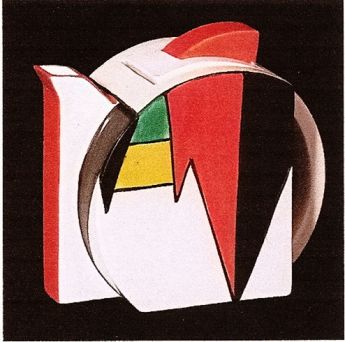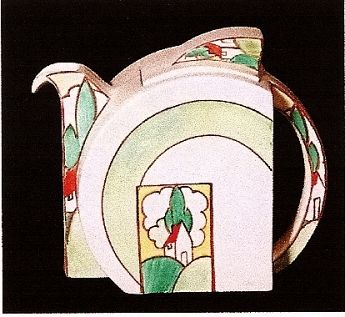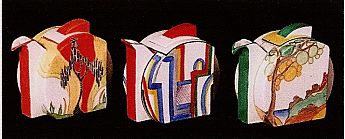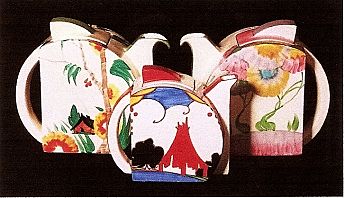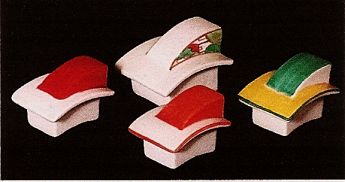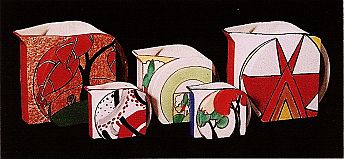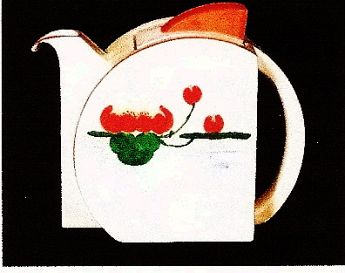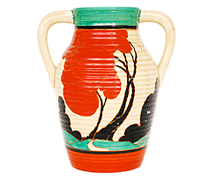Clarice Cliff Feature Articles
I seem to remember that many years ago the Original Clarice Cliff Collectors Club had a poll for the best Clarice Cliff shape and that honour went to the Stamford Teapot. It was a result I completely agree with, although with a bit of friendly persuasion, shapes like the YoYo vase could have, perhaps, beaten it. The difference between YoYo vases and Stamford Teapots is that YoYo vases are very rare and the chances of most collectors acquiring one are likewise. I therefore think that the Stamford Teapot is definitely the best “generally available shape”.
AN ICONIC ART DECO SHAPE
I have admired them for many years. Even now, 25 years later from when I first saw one, they never fail to raise a smile or a look of admiration, when I see one at fairs, auctions or on the internet.
The shape is based on a “D” with surrounding curves. Most of the straight lines and angles are juxtaposed with the curves, e.g. the straight back has the curved handle next to it and the curves of the front part of the “D” have the straight part of the spout body next to it. It is the juxtaposition of the angles and curves that make the Stamford Teapot such an iconic Art Deco shape that screams Deco.
The flat surfaces of the Stamford Teapot also provide an ideal canvas for the patterns. Even in a plain banded or shoulder pattern, the shape seems to add something special to the overall effect. The example shown in the Stroud pattern serves to highlight the added impact of putting any pattern on a Stamford. Nice touches include the pattern being applied to the handle, spout and lid.
The shape was introduced in 1930 and was issued for most of the decade. It can be found in numerous patterns including most of the Abstracts, Landscapes and later patterns such as Bamboo and Pink Pearls. I have yet to come across one in Original Bizarre, but the Flag example is perhaps the nearest. It was also issued in the various “alternatives” glazes such as Latona and Inspiration.
AN ELEMENT OF CONTROVERSY
Its introduction was not without controversy. Clarice was accused of “borrowing” the design from Tetard Freres, who were French silversmiths. A picture of the Tetard Freres version can be seen on page 30 of The Bizarre Affair by Leonard Griffin and Louis K. and Susan Pear Meisel. The similarity cannot be denied. However, making something in metal is a very different task from making it in pottery. Apparently, the technical people at Wilkinsons said it couldn’t be done. Clarice insisted that they try. The first attempts were a disaster, but she insisted they persevere and the rest is history.
SPOUT
The earlier Stamford Teapots have an angular spout. Apparently there were complaints that it didn’t pour very well and the spout was changed to what I call the “Teardrop spout”. Given a choice I prefer the angular version. The picture shows Stamfords in Windbells and Secrets with the Teardrop spout and the Tennis example with the earlier angular spout.
SIZE
The Stamford Teapot shape was issued in two sizes. The most common was the two-cup size (shown in Summerhouse) and the less common six-cup size (shown in Bamboo and Pink Pearls).
LID
The lid can be decorated in quite a few different ways. The most common is a plain honey glazed one with a painted knop. Sometimes it is only the top of the knop that is painted, but generally the knop is also painted on its sides. Another version has thin banding lines along the sides of the convex part of the lid. Also, the whole of the convex part can be painted with one of the colours of the pattern, with or without side banding lines. Finally, some versions have the pattern from the body carried over onto the lid.
AS A SET
As part of a tea set, it was combined with Conical cups and the same shape sugar bowl that was used for Bon Jour shape sets. The milk jug, however, is a dedicated shape and whereas on first glance it is similar to the Bon Jour shape, it has more angular ends. A matching Water Jug was also made for the Stamford sets that was the same shape as the milk jug, but in larger sizes. (The picture shows two large Water Jugs in Sunburst and Leaf Tree, a smaller one in Stroud and two of the usual size milk jugs in Carpet and a variation of Autumn.
The Stamford shape was also used by Wilkinsons for non-Clarice Cliff patterns (shown here in Water Lily).
All of the items shown have or are either in my collection or have been for sale on my website
COLIN MAWSTON
Edited by Doreen Mann
